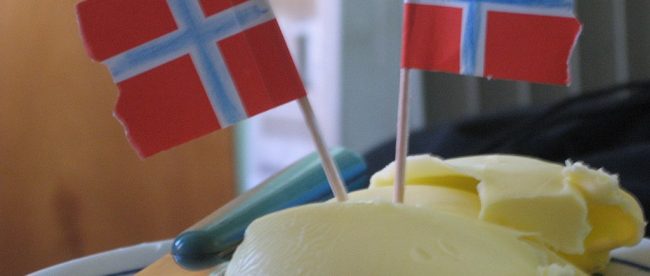The Great Norwegian Butter Crisis of 2011

Butter costs about $3.50 for a seven-ounce package, give or take. It’s a key ingredient in a lot of recipes which means that come the holidays, it’s in demand more than usual. But — it’s still butter. It’s still a rather common commodity, relatively available, and yes, will typically cost about the same, whether its Christmastime or the middle of March.
Unless something goes wrong like it did in Norway in 2011.
The problem began with bad weather: heavy rain in the summer that year meant lower quality feed for Norway’s cows to graze upon, and in turn, those cows produced less milk and therefore, less butter. Normally that wouldn’t be a big problem, though, because the bad weather wasn’t a global phenomenon. Norway could have just imported butter from, well, anywhere else on the planet.
Unfortunately, that wasn’t an option. The vast majority of Norweigan dairy output is controlled by Tine, a consortium of about 15,000 farmers. Tine, per Wikipedia, is typically incredibly successful, doing more than $3 billion in revenue each year, in part because it’s effectively a monopoly; “the corporation domestically offers the entire spectrum of dairy products, and in many dairy categories Tine faces little or no domestic competition.” Butter is one of those categories. And Tine’s hold on the Norwegian butter market isn’t limited to the fact that most of the nation’s producers are members of the collective. Norway also imposes a significant tariff on imported butter — more than $4 per kilogram (about 30 cents an ounce) at the time. In practice, this meant Norway didn’t import any butter; who would pay nearly twice as much for the imported stuff?
This left the country ill-prepared for the rainy summer of 2011. Tine didn’t scale back its own exports in response to the bad weather, so it didn’t have enough butter stored up to make up for the lower supply come the fall. To make matters even worse, a low-carb craze gripped the nation at the same time. As the Guardian reported, “demand for butter [rose] by 30%, while Norwegian cows produced 20m fewer liters of milk” compared to the year prior. Tine didn’t have nearly enough butter to meet the demand.
A panic ensued. As Christmas approached, the price of butter jumped twenty to thirty times higher than typical, hitting as much as $50 for about eight ounces. Naturally, a black market ensued. CNN reported that “authorities detained a Russian citizen [ . . . ] who they said was trying to smuggle 90 kilograms (200 pounds) of butter from Germany into Norway.” The New York Daily News relayed a story of two Swedish men who “were arrested with about 550 lbs of butter divided into 18-ounce packets;” they were expecting to make about $15,000 once they reached Norway. Airport duty-free shops began stocking butter. And there were probably many smugglers who succeeded in illegally importing theirs, tax-free.
Norway finally rolled back its tariffs temporarily, letting butter flow legally from outside its borders. The Norwegian butter crisis abated and by 2012, the prices fell back to normal.
Bonus fact: Perhaps the first American college protest was over butter. In 1766 — pre-America, but put that aside — students at Harvard University were upset that they were served rancid butter, and walked out of campus. (They ate in town instead, which was against the rules at the time.) The college admitted that the butter wasn’t good but didn’t care for the reaction; according to the Harvard Gazette, half the student body was suspended over the insubordination.
From the Archives: Dye It: Why margarine, the fake butter, was once pink.
